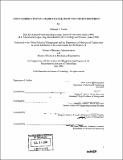| dc.contributor.advisor | Stephen C. Graves and Daniel E. Whitney. | en_US |
| dc.contributor.author | Vanka, Padmaja S. (Padmaja Surya), 1968- | en_US |
| dc.contributor.other | Leaders for Manufacturing Program. | en_US |
| dc.date.accessioned | 2006-11-08T16:35:37Z | |
| dc.date.available | 2006-11-08T16:35:37Z | |
| dc.date.copyright | 2004 | en_US |
| dc.date.issued | 2004 | en_US |
| dc.identifier.uri | http://hdl.handle.net/1721.1/34773 | |
| dc.description | Thesis (M.B.A.)--Massachusetts Institute of Technology, Sloan School of Management; and, (S.M.)--Massachusetts Institute of Technology, Dept. of Mechanical Engineering; in conjunction with the Leaders for Manufacturing Program at MIT, 2004. | en_US |
| dc.description | Includes bibliographical references (p. 89-90). | en_US |
| dc.description.abstract | Raytheon - Integrated Defense Systems (IDS) manufactures surface radars. In the past, Raytheon's Andover plant was primarily a systems integration facility receiving subassemblies from other sources to assemble the radars. Hence for a long time, building surface radars in low volume had been the norm. However, since the last few years the plant also has been producing some of these subassemblies in high volume. Due to this, the facility had to transition from a predominantly low volume manufacturing environment to one that includes high volume assembly lines. This thesis examines the challenges that arose due to the transition from a low volume to a high volume manufacturing environment. One of the major problems examined was throughput variability on a high volume assembly line. It has been determined that throughput variability can be reduced by achieving line coordination; i.e. "balance in the flow across the assembly line". This thesis emphasizes the importance of effective execution of the production plan to reduce throughput variability. It focuses on three key areas that needed improvement: Culture, Manufacturing Practices, and Business Systems. The thesis includes improvements implemented to achieve line coordination. | en_US |
| dc.description.statementofresponsibility | by Padmaja S. Vanka. | en_US |
| dc.format.extent | 90 p. | en_US |
| dc.format.extent | 3375981 bytes | |
| dc.format.extent | 3384431 bytes | |
| dc.format.mimetype | application/pdf | |
| dc.format.mimetype | application/pdf | |
| dc.language.iso | eng | en_US |
| dc.publisher | Massachusetts Institute of Technology | en_US |
| dc.rights | M.I.T. theses are protected by copyright. They may be viewed from this source for any purpose, but reproduction or distribution in any format is prohibited without written permission. See provided URL for inquiries about permission. | en_US |
| dc.rights.uri | http://dspace.mit.edu/handle/1721.1/7582 | |
| dc.subject | Sloan School of Management. | en_US |
| dc.subject | Mechanical Engineering. | en_US |
| dc.subject | Leaders for Manufacturing Program. | en_US |
| dc.title | Line coordination in a rapid change, high volume environment | en_US |
| dc.type | Thesis | en_US |
| dc.description.degree | S.M. | en_US |
| dc.description.degree | M.B.A. | en_US |
| dc.contributor.department | Leaders for Manufacturing Program at MIT | en_US |
| dc.contributor.department | Massachusetts Institute of Technology. Department of Mechanical Engineering | |
| dc.contributor.department | Sloan School of Management | |
| dc.identifier.oclc | 56721434 | en_US |
